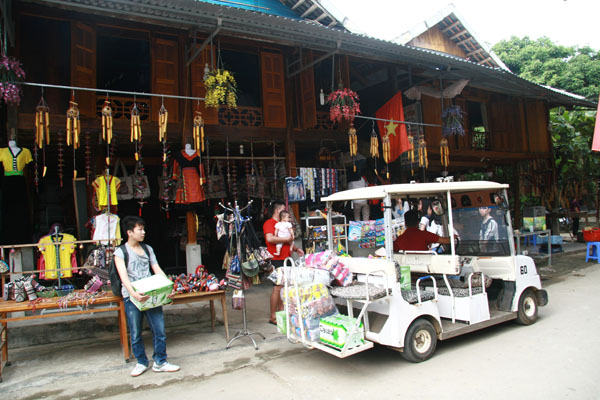
(HBO) – About 60km northwest of Hoa Binh city, Lac village of Chieng Chau commune, Mai Chau district, is hidden among mountain ranges. It is a popular destination, especially among those who passion natural beauty and ethnic minority culture.
Foreigners tour Lac village by bicycle
Lac village is situated in Mai Chau valley and is home to Thai ethnic people.
Once here the peace and picturesque that nature has given to this place become
apparent. In the past, locals depended on farming rice and making brocades for
a livelihood. However, the village’s hidden charm has recently been explored,
particularly through increasing community-based tourism, helping turn it into a
key tourism site of Mai Chau and the northwestern region.
The number of tourists to Lac village has risen in recent years. Stilt houses
have been upgraded but still have traditional features, while 57 houses provide
homestay services in the village at present. More than 12,880 tourists,
including about 2,950 foreigners, enjoyed the services in 2016. Service quality
is improving and foreigners are not overcharged as all service prices are
publicised. Tourists in groups can rent a stilt house at 500,000 – 1 million
VND (22 – 44 USD) while single travellers can rent a room at 200,000 VND (8.8
USD).
Lang Cam Van, a student of the University of Industry, said her group with more
than 50 members rented two houses at 750,000 VND (33 USD) each. The houses were
clean while the host was very friendly, making them feel at home.
Foreign visitors enjoy coming here. They can eat traditional dishes of Thai
ethnic people such as "ga doi” (free-range chicken), "mang dang” (bitter bamboo
shoot), "ruou can” (wine drunk out of a jar by pipes), and "nep nuong” (sticky rice
grown in hills). Daniel, a tourist from
New Zealand, said: "I love the food
here, especially "com lam” (bamboo-tube rice). This is the first time I seen
rice is cooked in a special way. The sticky rice in combination with coconut
and the typical fragrance of bamboo tubes create a perfect dish. We are not
confused by the language because local people could communicate in English
fluently. We also had a brocade weaving experience and joined art performances.
We made a lot of unforgettable memories in this place.”
Head of the Lac hamlet Ha Cong Hong said tourism is the main source of income
for locals at present. The previous year’s average per capita income was
estimated at 27 million VND. We are always aware of improving service quality
to attract visitors. Social order and security are ensured. We plan to build a
tourism development project and create flower gardens for visitors to take
photos.
According to Hong, locals understand that a good environment will boost
community-based tourism. Households clean the streets and dredge the sewers.
However, there are no effective measures to treat waste, with most rubbish
burnt. Local communes have encouraged families to contribute money to hire an
environment company to collect garbage.
Dong Huong
The Muong group is one of the largest ethnic minorities in Vietnam, primarily found in Hoa Binh province. The Muong people in Hoa Binh boast a rich and diverse cultural treasure that reflects the unique identity of this ethnic group. Accounting for over 63% of the province's population, they have created and preserved numerous distinctive cultural values, contributing to their unique identity. Their cultural heritage is an invaluable asset, at the heart of their national identity, and represents a vibrant spiritual life that must be preserved and promoted in today’s modern world.
For generations, the ethnic communities of Hoa Binh province, particularly the Muong people, have preserved vibrant festivals deeply intertwined with the region’s geography, nature, and social traditions. These celebrations enrich Hoa Binh’s spiritual life and cultural identity, reflecting both folk beliefs and the intermingling of ethnic customs. Many of these festivals have endured the test of time, passed down through generations and continuing to thrive today. Among them, the Khai Ha (Going Down to the Field) festival stands out as one of the most significant events of the Muong ethnic group.
Muong calendar, known as sach doi, is an ancient folk knowledge system developed through observations of the movement of the pleiades star. This unique calendar consists of 12 bamboo sticks, each representing a lunar month. Specific days within each month are marked with distinct symbols, guiding locals in determining auspicious and inauspicious days for important activities.
Authorities and residents of Chieng Chau commune, Mai Chau district, are making efforts to preserve and promote the historical value of a centuries-old gold apple tree (scientifically known as diospyros decandra lour), which has been recognised as a national heritage tree.
Hoa Binh is home to two types of Dong Son drums: Heger I and Heger II. These drums date back from the 4th century BC to the 5th century AD.
Mo is a term referring to a profession and cultural heritage which integrates folk beliefs with folk culture and arts. Practiced at funerals and religious rituals by the Muong ethnic people, it aims to provide spiritual comfort during significant life events such as illness and death.


